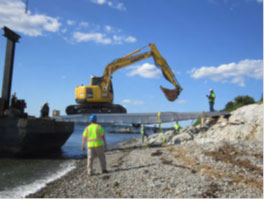Remediation of Contaminated Soils
Baker’s Island
Salem, Massachusetts
 Watermark completed remediation of lead-impacted soil and a lead-based paint abatement project at the historic Baker’s Island Light on Baker’s Island, Salem, Massachusetts. Work was completed on behalf of the United States Coast Guard (USCG) to address environmental impacts to soil associated with the weathering of lead-based paint on the lighthouse, keeper’s dwellings, and other USCG structures occupying approximately 10 acres on the north side of the island.
Watermark completed remediation of lead-impacted soil and a lead-based paint abatement project at the historic Baker’s Island Light on Baker’s Island, Salem, Massachusetts. Work was completed on behalf of the United States Coast Guard (USCG) to address environmental impacts to soil associated with the weathering of lead-based paint on the lighthouse, keeper’s dwellings, and other USCG structures occupying approximately 10 acres on the north side of the island.
The project presented numerous unique logistical challenges due to its geographic location five miles off-shore, the absence of a permissible docking facility, avoidance of beach crossings, tidal impacts on work schedules, coordination of multiple subcontractors working simultaneously, and stakeholder desires/concerns.
Soil remediation included the excavation of more than 1,400 cubic yards of lead-impacted soil with concentrations over 3,000 milligrams per kilogram. Initially the area was gridded and samples were collected for waste characterization analysis, including Toxicity Characteristic Leaching Procedure (TCLP) for lead. Any soil that failed TCLP analysis was subsequently treated in-situ using a commercial product for stabilizing metals in soil and was then resampled. Upon confirmation that the treated soil did not fail TCLP testing, the treated and un-treated soil was removed to a depth of one-foot below ground surface and direct-loaded into woven polypropylene flexible intermediate bulk containers. This eliminated the need to manage soil stockpiles and any associated public perception issues. The containers were transported to a staging area platform, hoisted onto a waiting barge via crane, and transported to the mainland for disposal.
 Site restoration consisted of emplacement of dense grade, stone and loam barged from the mainland. Other site tasks included demolition of a storage building; containerization, transportation, and disposal of approximately 28 tons of construction debris and accumulated trash; and draining of heating oil tanks and removal of fuel lines.
Site restoration consisted of emplacement of dense grade, stone and loam barged from the mainland. Other site tasks included demolition of a storage building; containerization, transportation, and disposal of approximately 28 tons of construction debris and accumulated trash; and draining of heating oil tanks and removal of fuel lines.
